Exploration of Informal Farmland Leasing Mode: A Case Study of Huang Village in China
Abstract
:1. Introduction
2. Materials and Methods
2.1. Study Area
2.2. Data Collection
2.3. Methods
2.3.1. Establishment of Farmland Leasing Network
2.3.2. Network Measures
2.3.3. Node Measures
3. Results
3.1. Descriptive Analysis Results
3.1.1. The General Characteristics of Huang Village
3.1.2. The Characteristics of Household in Huang Village
3.1.3. Farmland Leasing in Huang Village: Current Situation and Changes
3.2. SNA Analysis Results
3.2.1. Network Level Results
3.2.2. Node Level Results
4. Discussions
4.1. Rethinking Trends and Consequences of Informalfarmland Leasing
4.2. Limitations and Extensions
5. Conclusions
Author Contributions
Funding
Institutional Review Board Statement
Informed Consent Statement
Data Availability Statement
Conflicts of Interest
References
- Lipton, M. From Policy Aims and Small-farm Characteristics to Farm Science Needs. World Dev. 2010, 38, 1399–1412. [Google Scholar] [CrossRef]
- Potter, C.; Tilzey, M. Agricultural multifunctionality, environmental sustainability and the WTO: Resistance or accommodation to the neoliberal project for agriculture? Geoforum 2007, 38, 1290–1303. [Google Scholar] [CrossRef]
- Tilt, B. Smallholders and the ‘Household Responsibility System’: Adapting to Institutional Change in Chinese Agriculture. Hum. Ecol. 2007, 36, 189–199. [Google Scholar] [CrossRef]
- Zhang, J.; Mishra, A.K.; Hirsch, S.; Li, X. Factors affecting farmland rental in rural China: Evidence of capitalization of grain subsidy payments. Land Use Policy 2020, 90, 104275. [Google Scholar] [CrossRef]
- Ye, J. Land Transfer and the Pursuit of Agricultural Modernization in China: Land Transfer and Agricultural Modernization in China. J. Agrar. Chang. 2015, 15, 314–337. [Google Scholar] [CrossRef]
- Yang, X.; Sui, P.; Zhang, X.; Dai, H.; Yan, P.; Li, C.; Wang, X.; Chen, Y. Environmental and economic consequences analysis of cropping systems from fragmented to concentrated farmland in the North China Plain based on a joint use of life cycle assessment, emergy and economic analysis. J. Environ. Manag. 2019, 251, 109588. [Google Scholar] [CrossRef] [PubMed]
- Lin, J.Y. Rural Reforms and Agricultural Growth in China. Am. Econ. Rev. 1992, 82, 34–51. [Google Scholar]
- Tongwei, Q.; Luo, B.; Choy, S.T.B.; Li, Y.; He, Q. Do land renting-in and its marketization increase labor input in agriculture? Evidence from rural China. Land Use Policy 2020, 99, 104820. [Google Scholar] [CrossRef]
- Xiao, W.; Zhao, G. Who is affected: Influence of agricultural land on occupational choices of peasants in China. Land Use Policy 2020, 99, 104827. [Google Scholar] [CrossRef]
- Liu, J.-C.; Xu, Z.-G.; Zheng, Q.-F.; Hua, L. Is the feminization of labor harmful to agricultural production? The decision-making and production control perspective. J. Integr. Agric. 2019, 18, 1392–1401. [Google Scholar] [CrossRef]
- Stecklov, G.; Winters, P.; Stampini, M.; Davis, B. Do Conditional Cash Transfers Influence Migration? A Study Using Experimental Data from the Mexican Progresa Program. Demography 2005, 42, 769–790. [Google Scholar] [CrossRef] [PubMed]
- Hu, Z.; Rahman, S. Economic drivers of contemporary smallholder agriculture in a transitional economy: A case study of Hu Village from southwest China: Smallholder agriculture in China. Singap. J. Trop. Geogr. 2015, 36, 324–341. [Google Scholar] [CrossRef] [Green Version]
- Xu, D.; Deng, X.; Guo, S.; Liu, S. Labor migration and farmland abandonment in rural China: Empirical results and policy implications. J. Environ. Manag. 2018, 232, 738–750. [Google Scholar] [CrossRef] [PubMed]
- Wan, E.C.G.H.; Cheng, E. Effects of land fragmentation and returns to scale in the Chinese farming sector. Appl. Econ. 2001, 33, 183–194. [Google Scholar] [CrossRef]
- Wang, Q.; Zhang, X. Three rights separation: China’s proposed rural land rights reform and four types of local trials. Land Use Policy 2017, 63, 111–121. [Google Scholar] [CrossRef]
- Zhuo, Y.; Xu, Z.; Li, G.; Liao, R.; Lemmen, C.; Wu, C.; Wu, Y. LADM-based profile for farmland Tripartite Entitlement System in China. Land Use Policy 2020, 92, 104459. [Google Scholar] [CrossRef]
- Yuan, X.; Du, W.; Wei, X.; Ying, Y.; Shao, Y.; Hou, R. Quantitative analysis of research on China’s land transfer system. Land Use Policy 2018, 74, 301–308. [Google Scholar] [CrossRef]
- Benjamin, D.; Brandt, L. Property rights, labour markets, and efficiency in a transition economy: The case of rural China. Can. J. Econ. Rev. Can. D’Econ. 2002, 35, 689–716. [Google Scholar] [CrossRef]
- Gao, J.; Song, G.; Sun, X. Does labor migration affect rural land transfer? Evidence from China. Land Use Policy 2020, 99, 105096. [Google Scholar] [CrossRef]
- China Agriculture Press. Ministry of Agriculturee and Rural Affairs China Agriculture Statistical Report (2015); China Agriculture Press: Beijing, China, 2016. [Google Scholar]
- Ye, J.; Feng, L.; Jiang, Y.; Lang, Y.; Prosterman, R. 2016 Rural Land use Rights Survey in China—Survey results and Policy Recommendations in 17 provinces. Manag. World 2018, 34, 98–108. [Google Scholar] [CrossRef]
- Deininger, K.; Jin, S. Securing property rights in transition: Lessons from implementation of China’s rural land contracting law. J. Econ. Behav. Organ. 2009, 70, 22–38. [Google Scholar] [CrossRef] [Green Version]
- Valliant, J.C.; Ruhf, K.Z.; Gibson, K.D.; Brooks, J.; Farmer, J.R. Fostering farm transfers from farm owners to unrelated, new farmers: A qualitative assessment of farm link services. Land Use Policy 2019, 86, 438–447. [Google Scholar] [CrossRef]
- Vranken, L.; Swinnen, J. Land rental markets in transition: Theory and evidence from Hungary. World Dev. 2006, 34, 481–500. [Google Scholar] [CrossRef]
- Zhang, Y.; Wang, X.; Glauben, T.; Brümmer, B. The impact of land reallocation on technical efficiency: Evidence from China. Agric. Econ. 2011, 42, 495–507. [Google Scholar] [CrossRef]
- Shi, X.; Chen, S.; Ma, X.; Lan, J. Heterogeneity in interventions in village committee and farmland circulation: Intermediary versus regulatory effects. Land Use Policy 2018, 74, 291–300. [Google Scholar] [CrossRef]
- Gao, L.; Huang, J.; Rozelle, S. Rental markets for cultivated land and agricultural investments in China. Agric. Econ. 2012, 43, 391–403. [Google Scholar] [CrossRef]
- Hua, X.; Kono, Y.; Zhang, L.; Xu, E.; Luo, R. Land rental in a multi-ethnic society: Insights from Southwest China. Land Use Policy 2020, 97, 104743. [Google Scholar] [CrossRef]
- Teklu, T.; Lemi, A. Factors affecting entry and intensity in informal rental land markets in Southern Ethiopian highlands. Agric. Econ. 2004, 30, 117–128. [Google Scholar] [CrossRef]
- Wang, Y.H.; Xin, L.J.; Zhang, H.Z.; Li, Y.Q. An Estimation of the Extent of Rent-Free Farmland Transfer and Its Driving Forces in Rural China: A Multilevel Logit Model Analysis. Sustainability 2019, 11, 3161. [Google Scholar] [CrossRef] [Green Version]
- Deininger, K.; Jin, S. The potential of land rental markets in the process of economic development: Evidence from China. J. Dev. Econ. 2005, 78, 241–270. [Google Scholar] [CrossRef]
- Wang, X.Q.; Zhou, W.; Zhu, G.L.; Cao, T. The impact of local government-dominated farmland transfer on farmers’ transfer scale and grain yield in five cities in Jiangsu. Resour. Sci. 2018, 40, 326–334. [Google Scholar]
- Zhang, J.; Zhu, P.X. The effect of different farmland transfer patterns on household agricultural productivity based on surveys of four counties in Jiangsu province. Resour. Sci. 2017, 39, 629–640. [Google Scholar]
- Huang, Z.F. Disembeddedness and re-embeddedness: Agricultural operation and governance in village order. China Rural. Surv. 2018, 3, 51–64. [Google Scholar]
- Villarreal, A. The U.S. occupational structure: A social network approach. Sociol. Sci. 2020, 7, 187–221. [Google Scholar] [CrossRef]
- Felzensztein, C.; Gimmon, E. Industrial clusters and social networking for enhancing inter-firm cooperation: The case of natural resources-based industries in Chile. J. Bus. Mark. Manag. 2008, 2, 187–202. [Google Scholar] [CrossRef]
- Shen, C.-L.; Tai, H.-S. Values matter: The role of key nodes of social networks in an environmental governance case from Taiwan. Environ. Manag. 2021, 67, 251–262. [Google Scholar] [CrossRef]
- Genç, S.; Akay, D.; Boran, F.E.; Yager, R.R. Linguistic summarization of fuzzy social and economic networks: An application on the international trade network. Soft Comput. 2020, 24, 1511–1527. [Google Scholar] [CrossRef]
- Fritsch, M.; Kauffeld-Monz, M. The impact of network structure on knowledge transfer: An application of social network analysis in the context of regional innovation networks. Ann. Reg. Sci. 2010, 44, 21–38. [Google Scholar] [CrossRef] [Green Version]
- Zhou, L.; Zhang, W.; Fang, C.; Sun, H.; Lin, J. Actors and network in the marketization of rural collectively-owned commercial construction land (RCOCCL) in China: A pilot case of Langfa, Beijing. Land Use Policy 2020, 99, 104990. [Google Scholar] [CrossRef]
- Brangier, V. Intermediación y Grado en una red de venta de tierras: Valle de Pichidegua, Chile, 1820-1835. Caravelle 2018, 111, 147–162. [Google Scholar] [CrossRef]
- Ouyang, Y.Q. Social network analysis and its application to innovative research. Chin. J. Manag. 2009, 6, 1188–1193; 1203. [Google Scholar]
- Marsden, P.V. Network Data and Measurement. Annu. Rev. Sociol. 1990, 16, 435–463. [Google Scholar] [CrossRef]
- Wasserman, S.; Faust, K. Social Network Analysis: Methods and Applications; Cambridge University Press: New York, NY, USA, 1994. [Google Scholar]
- Mitchell, J.C. The Concept and Use of Social Network in Urban Situations; Manchester University Press: Manchester, UK, 1969; pp. 1–50. [Google Scholar]
- Borgatti, S.P.; Everett, M.; Freeman, L.C. Ucinet 6 for Windows: Software for Social Network Analysis User’s Manual; Analytic Technologies, Inc.: Harvard, MA, USA, 2002. [Google Scholar]
- Bastian, M.; Heymann, S.; Jacomy, M. Gephi: An Open Source Software for Exploring and Manipulating Networks. In Proceedings of the International AAAI Conference on Web and Social Media, San Jose, CA, USA, 17–20 May 2009; pp. 361–362. [Google Scholar]
- Luser, D.; Johan, K.; Garry, R. Exponential Random Graph Models for Social Networks: Theory, Methods, and Applications; Cambridge University Press: London, UK, 2012. [Google Scholar]
- Clemente, G.; Grassi, R. Directed clustering in weighted networks: A new perspective. Chaos Solitons Fractals 2017, 107, 26–38. [Google Scholar] [CrossRef] [Green Version]
- Freeman, L.C. Centrality in social networks conceptual clarification. Soc. Netw. 1978, 1, 215–239. [Google Scholar] [CrossRef] [Green Version]
- Liu, J. An Introduction to Social Network Analysis; Social Sciences Academic Press (CHINA): Beijing, China, 2004; pp. 119–120. [Google Scholar]
- Fornito, A.; Zalesky, A.; Bullmore, E. Fundamentals of Brain Network Analysis; Elsevier Academic Press: San Diego, CA, USA, 2016; p. xvii476. [Google Scholar]
- Jun, H.; Qing, L.; Shu-chi, Z. Family Gender Division and Agriculture Feminization-an Analysis Based on 408 Families in Jiangsu Province. J. Nanjing Agric. Univ. (Soc. Sci. Ed.) 2010, 10, 50–56. [Google Scholar]
- Liao, L.; Long, H.; Gao, X.; Ma, E. Effects of land use transitions and rural aging on agricultural production in China’s farming area: A perspective from changing labor employing quantity in the planting industry. Land Use Policy 2019, 88, 104152. [Google Scholar] [CrossRef]
- Liu, K.; Wang, X.; Yan, Y. Network Analysis of Industrial Symbiosis in Chemical Industrial Parks: A Case Study of Nanjing Jiangbei New Materials High-Tech Park. Sustainability 2022, 14, 1381. [Google Scholar] [CrossRef]
- Holden, S.T.; Otsuka, K. The roles of land tenure reforms and land markets in the context of population growth and land use intensification in Africa. Food Policy 2014, 48, 88–97. [Google Scholar] [CrossRef] [Green Version]
- Chen, X.B.; Wu, K.P.; He, Y.L. The effect of farmland circulation on farmers’ productivity: An empirical analysis based on DEA methods. J. Agrotech. Econ. 2011, 8, 65–71. [Google Scholar]
- Ayala-Cantu, L.; Morando, B. Rental markets, gender, and land certificates: Evidence from Vietnam. Food Policy 2020, 94, 101842. [Google Scholar] [CrossRef]
- Mudimu, G.T.; Zuo, T.; Shah, A.A.; Nalwimba, N.; Ado, A.M. Land leasing in a post-land reform context: Insights from Zimbabwe. GeoJournal 2020, 86, 2927–2943. [Google Scholar] [CrossRef]
- Akter, S.; Farrington, J.; Deshingkar, P.; Sharma, P.; Rao, L. Land rental markets in India: Efficiency and equity considerations. In Proceedings of the Contributed paper prepared for presentation at the International Association of Agricultural Economists Conference, Gold Coast, Australia, 12–18 August 2006. [Google Scholar]
- Mandal, S.; Misra, G.V.; Naqvi, S.M.A.; Kumar, N. Situational analysis of agricultural land leasing in Uttar Pradesh. Land Use Policy 2019, 88, 104106. [Google Scholar] [CrossRef]
- Huang, Z.H.; Wang, P. Farmland transfer and its impact on the development of modern agriculture: Status, problems and solutions. J. Zhejiang Univ. (Humanit. Soc. Sci.) 2008, 2, 38–47. [Google Scholar]
- Zou, B.; Zhong, W.; Zhang, Q. Risk aversion and the duration of the rural land lease contract: An empirical analysis based on the survey of rural households in Guangdong. South China J. Econ. 2016, 35, 12–22. [Google Scholar]
- Rogers, S.; Wilmsen, B.; Han, X.; Wang, Z.J.-H.; Duan, Y.; He, J.; Li, J.; Lin, W.; Wong, C. Scaling up agriculture? The dynamics of land transfer in inland China. World Dev. 2021, 146, 105563. [Google Scholar] [CrossRef]
- Yang, H. Rural land circulation and the restructuring of social classes. Chongqing Soc. Sci. 2011, 5, 54–60. [Google Scholar]
- Davis, K.F.; D’Odorico, P.; Rulli, M.C. Land grabbing: A preliminary quantification of economic impacts on rural livelihoods. Popul. Environ. 2014, 36, 180–192. [Google Scholar] [CrossRef] [Green Version]
- Wang, Y.M. The socialized farmers of China and circulation of farmland. Issues Agric. Econ. 2010, 31, 45–50. [Google Scholar]
- Mertens, K.; Vranken, L. Pro-poor land transfers in the presence of landslides: New insights on norms in land markets. Land Use Policy 2021, 101, 105202. [Google Scholar] [CrossRef]
- Wang, H.; Riedinger, J.; Jin, S. Land documents, tenure security and land rental development: Panel evidence from China. China Econ. Rev. 2015, 36, 220–235. [Google Scholar] [CrossRef]
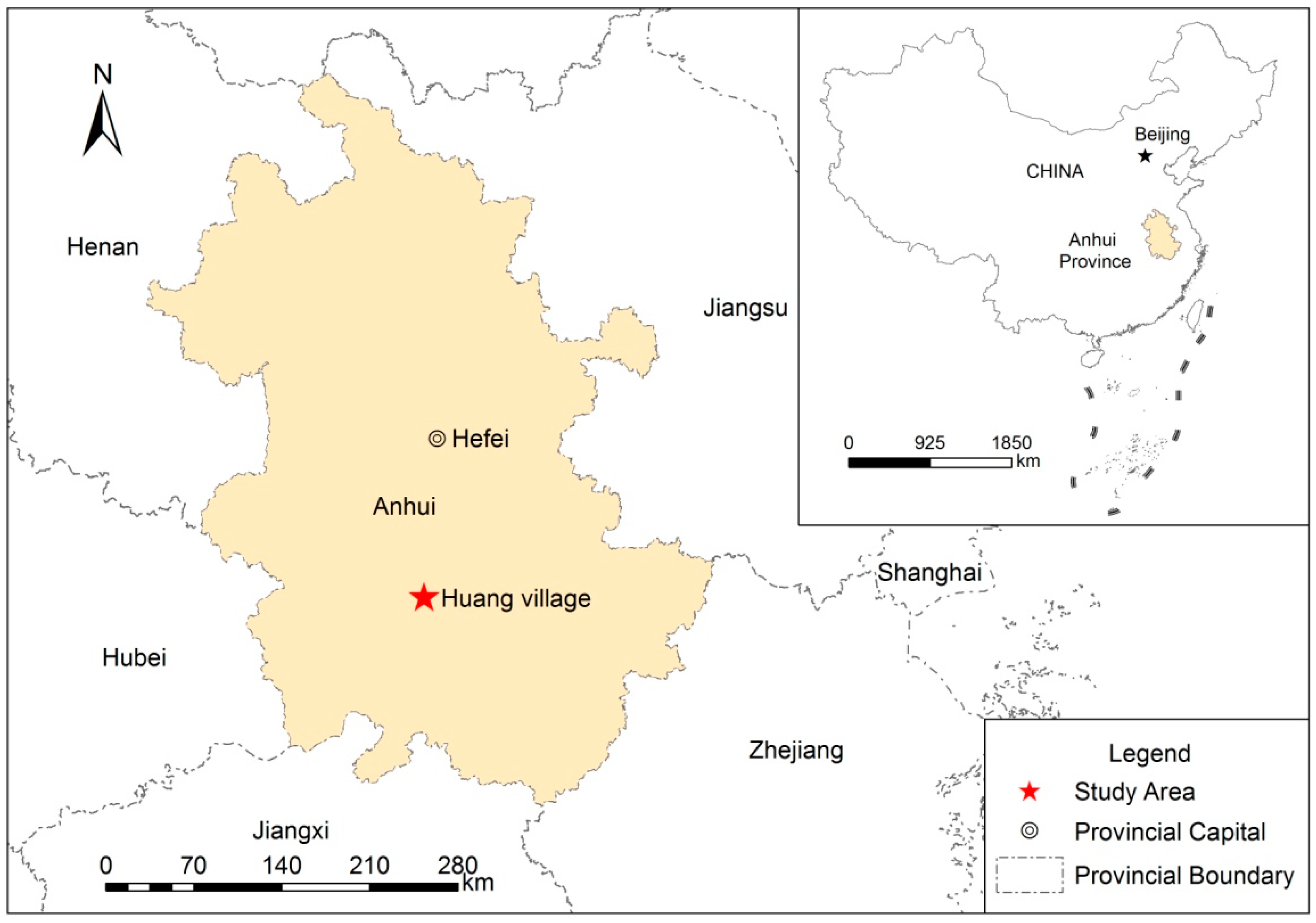
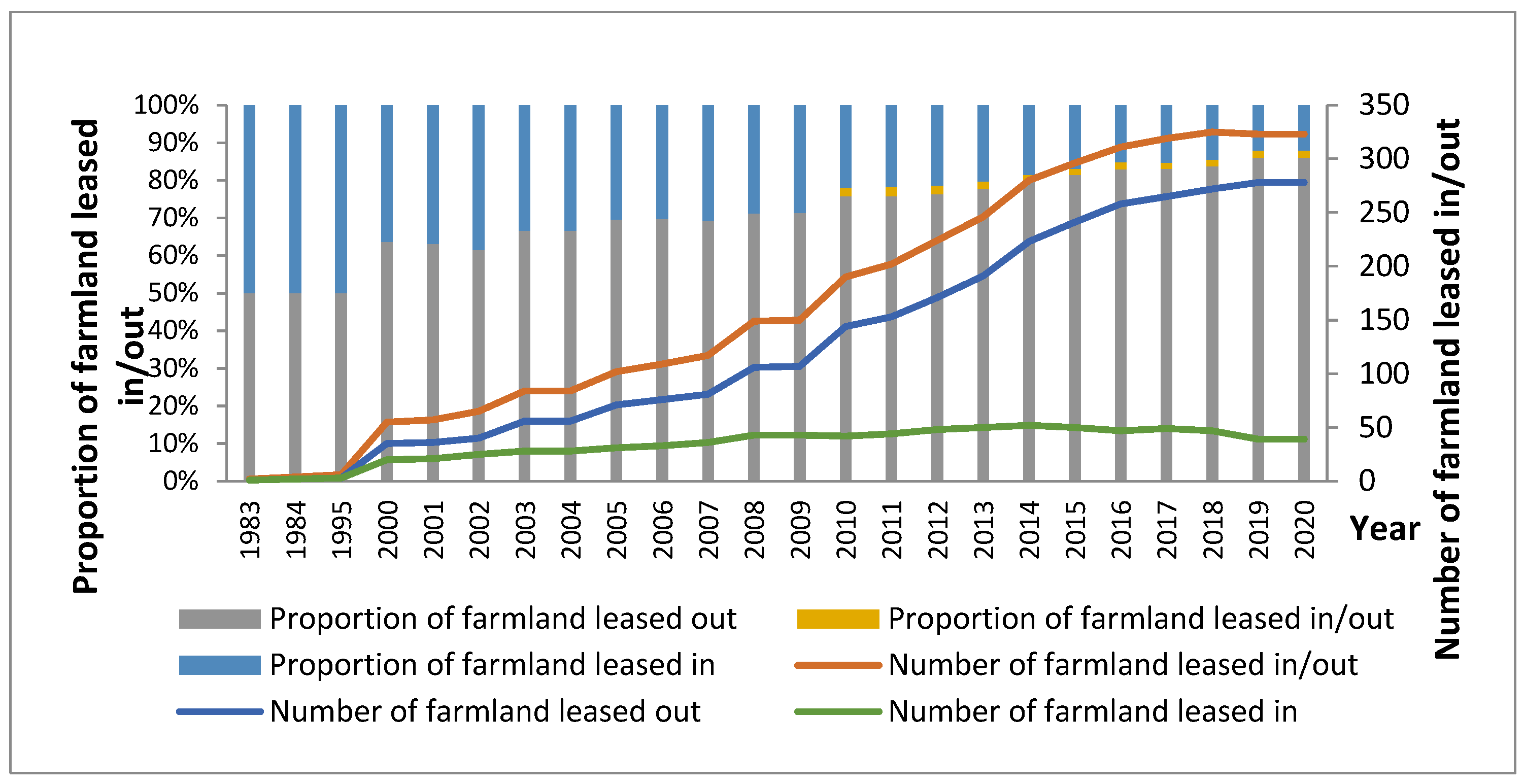
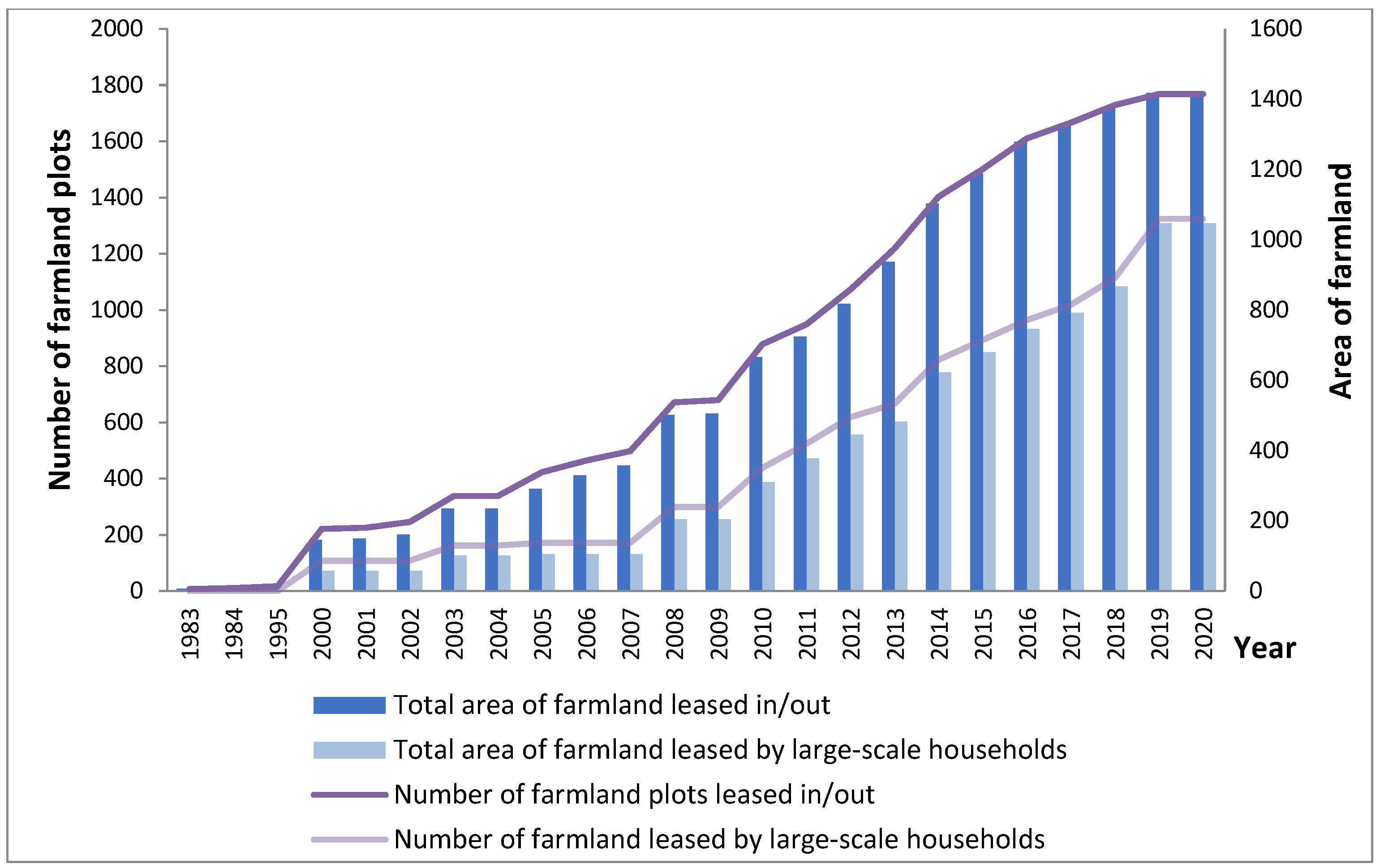
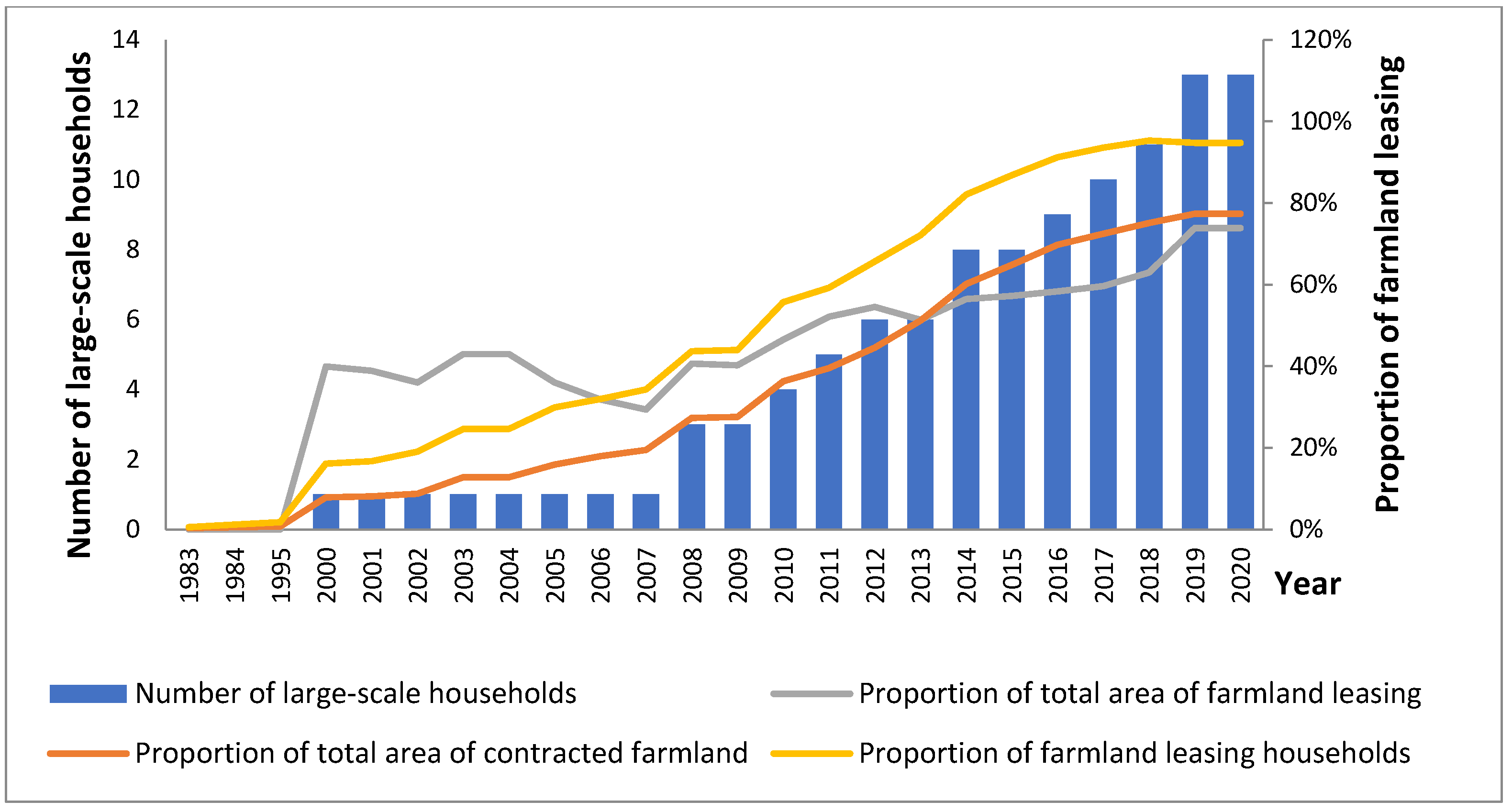
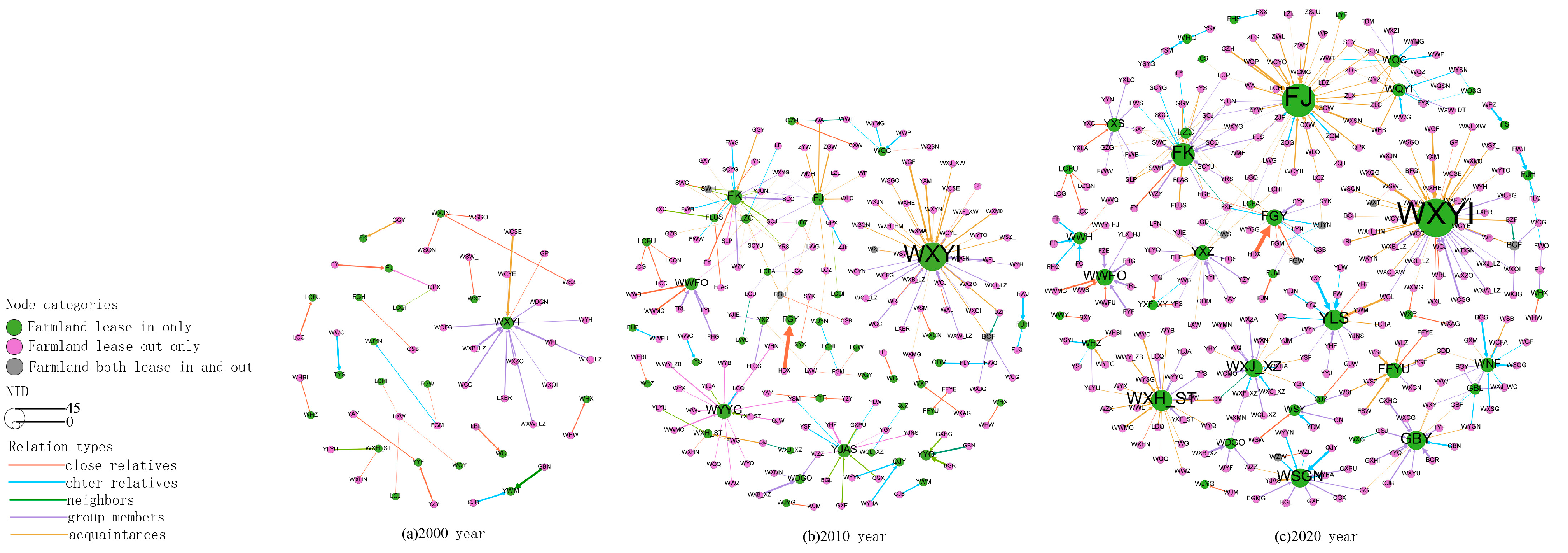
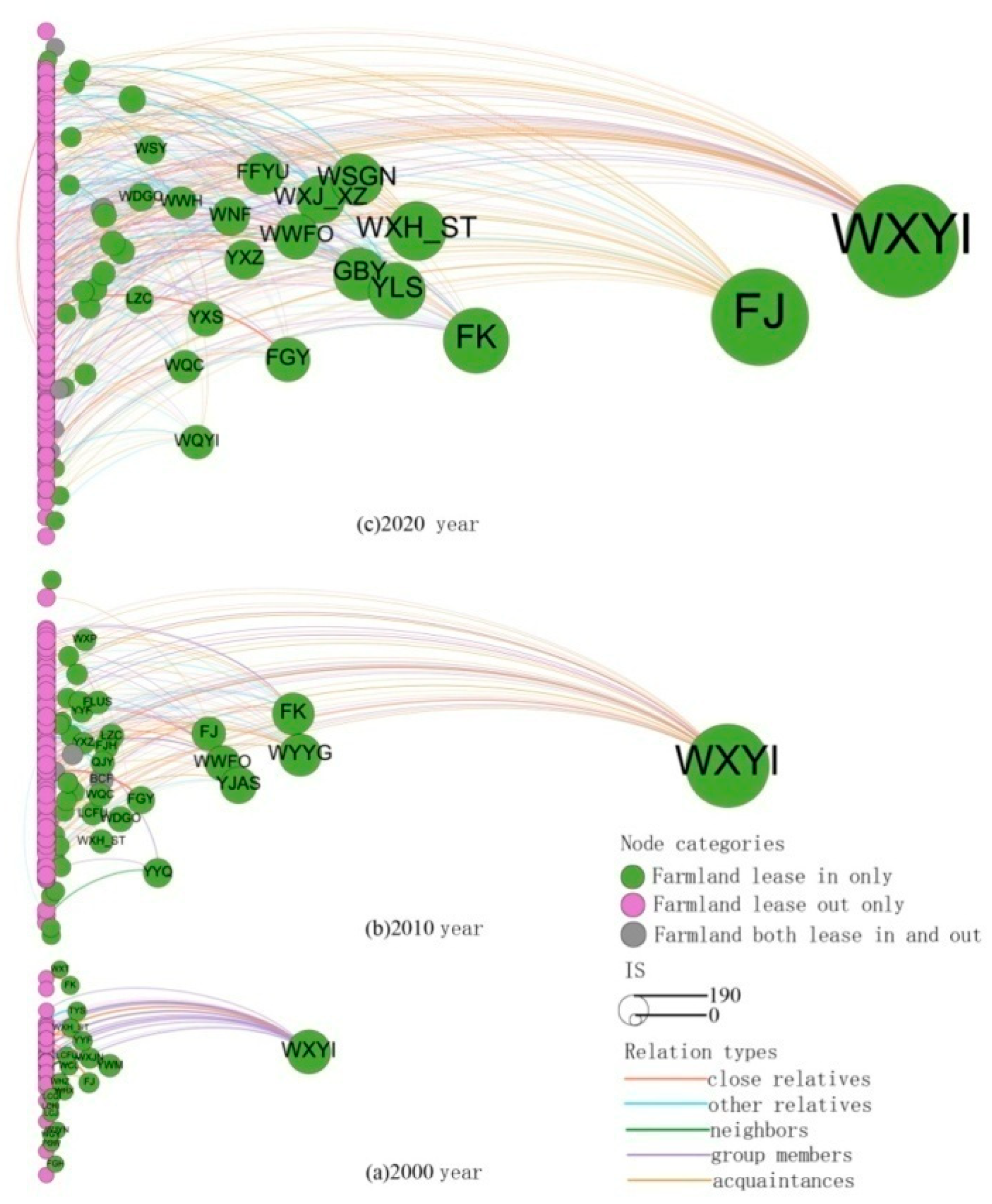
| Frequencies | Percentage (%) | ||
|---|---|---|---|
| Villager | In total | 1343 | - |
| Female | 630 | 46.9 | |
| Labor force | In total | 829 | - |
| Non-farmer | 674 | 81.3 | |
| Part-time farmer | 10 | 1.2 | |
| Full-time farmer | 145 | 17.5 | |
| Female farmer | 69 | 47.6 | |
| Average age of farmer | 62 | - |
| Frequencies | Percentage (%) | ||
|---|---|---|---|
| Household number | 341 | - | |
| Average age of householder | ≤40 | 6 | 1.76 |
| 40–49 | 68 | 19.94 | |
| 50–59 | 117 | 34.31 | |
| 60–69 | 83 | 24.34 | |
| 70–79 | 59 | 17.3 | |
| ≥80 | 8 | 2.35 | |
| Number of household member | 1–2 | 76 | 22.29 |
| 3–4 | 150 | 43.99 | |
| 5–6 | 95 | 27.86 | |
| ≥7 | 20 | 5.86 | |
| Labor force per household | 0 | 36 | 10.6 |
| 1–2 | 157 | 46 | |
| 3–4 | 129 | 37.8 | |
| ≥5 | 19 | 5.6 | |
| Agricultural labor force per household | 0 | 253 | 74.2 |
| 1 | 31 | 9.1 | |
| 2 | 57 | 16.7 | |
| Off-farm labor force per household | 0 | 62 | 18.2 |
| 1–2 | 171 | 50.1 | |
| 3–4 | 94 | 27.6 | |
| 5–6 | 14 | 4.1 | |
| Household income | ≤10,000 | 53 | 15.54 |
| 10,001–50,000 | 53 | 15.54 | |
| 50,001–100,000 | 137 | 40.18 | |
| 100,001–150,000 | 56 | 16.42 | |
| ≥150,000 | 42 | 12.32 | |
| Household income composition | Agricultural income | 83 | 24.34 |
| Non-agricultural income | 283 | 82.99 | |
| Agriculture and non-agriculture | 62 | 18.18 | |
| Over half from agricultural income | 29 | 8.5 | |
| Areas of Contracted farmland (mu) | ≤2 | 25 | 7.33 |
| 2–3 | 30 | 8.8 | |
| 3–4 | 52 | 15.25 | |
| 4–5 | 76 | 22.29 | |
| 5–8 | 118 | 34.6 | |
| ≥8 | 40 | 11.73 | |
| Numbers of plots per household | ≤3 | 24 | 7.04 |
| 4–5 | 95 | 27.86 | |
| 6–7 | 107 | 31.38 | |
| 8–9 | 68 | 19.94 | |
| ≥10 | 47 | 13.78 |
| Household Proportion (n = 341) | Proportion of Contracted Farmland Area (mu) (n = 1832.6) | Proportion of Contracted Farmland Plots (n = 2284) | ||
|---|---|---|---|---|
| General information | ||||
| In total | 96.5%/329 | 79.9%/1464.9 | 80.1%/1830 | |
| Location of leased farmland | Neighboring village | 1.8%/6 | 2.5%/47 | 2.7%/62 |
| Own village and neighboring village | 2.1%/7 | _ | _ | |
| Own village | 92.6%/316 | 77.4%/1417.9 | 77.4%/1768 | |
| Detailed information (farmland leasing relationship level) | ||||
| # Farmland leasing relationship | 370 | 1417.9 | 1768 | |
| Relationship Type | Close relatives | 9.2%/34 | 9.3%/132.4 | 10.5%/185 |
| Other relatives | 17%/63 | 20.6%/292.7 | 16.5%/325 | |
| Neighbors | 0.6%/2 | 0.4%/5.2 | 0.3%/6 | |
| Group members | 33.8%/125 | 35.6%/504.4 | 34.8%/615 | |
| Acquaintances | 39.4%/146 | 34.1%/482.2 | 37.9%/670 | |
| No. | 2000 | 2010 | 2020 | |||
|---|---|---|---|---|---|---|
| Name | NID | Name | NID | Name | NID | |
| 1 | WXYI | 0.170 | WXYI | 0.451 | WXYI | 0.560 |
| 2 | YWM | 0.041 | WYYG | 0.168 | FJ | 0.467 |
| 3 | FJ | 0.028 | FK | 0.164 | FK | 0.281 |
| 4 | WXJN | 0.028 | YJAS | 0.127 | WXH_ST | 0.242 |
| 5 | YYF | 0.024 | WWFO | 0.117 | YLS | 0.229 |
| 6 | TYS | 0.018 | FJ | 0.107 | GBY | 0.205 |
| 7 | WXH_ST | 0.016 | YYQ | 0.074 | WSGN | 0.203 |
| 8 | FK | 0.015 | FGY | 0.063 | WXJ_XZ | 0.179 |
| 9 | WCL | 0.015 | WDGO | 0.049 | WWFO | 0.164 |
| 10 | LCFU | 0.013 | LZC | 0.043 | FGY | 0.158 |
| 11 | WHX | 0.012 | FJH | 0.040 | FFYU | 0.142 |
| 12 | WXT | 0.009 | BCF | 0.037 | YXZ | 0.130 |
| 13 | WHZ | 0.009 | QJY | 0.037 | WNF | 0.121 |
| 14 | WJYN | 0.007 | WQC | 0.037 | YXS | 0.104 |
| 15 | FGH | 0.006 | WXH_ST | 0.036 | WQYI | 0.099 |
Publisher’s Note: MDPI stays neutral with regard to jurisdictional claims in published maps and institutional affiliations. |
© 2022 by the authors. Licensee MDPI, Basel, Switzerland. This article is an open access article distributed under the terms and conditions of the Creative Commons Attribution (CC BY) license (https://creativecommons.org/licenses/by/4.0/).
Share and Cite
Fang, T.; Zhuo, Y.; Wu, C.; Zhou, Y.; Xu, Z.; Li, G. Exploration of Informal Farmland Leasing Mode: A Case Study of Huang Village in China. Land 2022, 11, 756. https://doi.org/10.3390/land11050756
Fang T, Zhuo Y, Wu C, Zhou Y, Xu Z, Li G. Exploration of Informal Farmland Leasing Mode: A Case Study of Huang Village in China. Land. 2022; 11(5):756. https://doi.org/10.3390/land11050756
Chicago/Turabian StyleFang, Tingting, Yuefei Zhuo, Cifang Wu, Yihu Zhou, Zhongguo Xu, and Guan Li. 2022. "Exploration of Informal Farmland Leasing Mode: A Case Study of Huang Village in China" Land 11, no. 5: 756. https://doi.org/10.3390/land11050756
APA StyleFang, T., Zhuo, Y., Wu, C., Zhou, Y., Xu, Z., & Li, G. (2022). Exploration of Informal Farmland Leasing Mode: A Case Study of Huang Village in China. Land, 11(5), 756. https://doi.org/10.3390/land11050756






